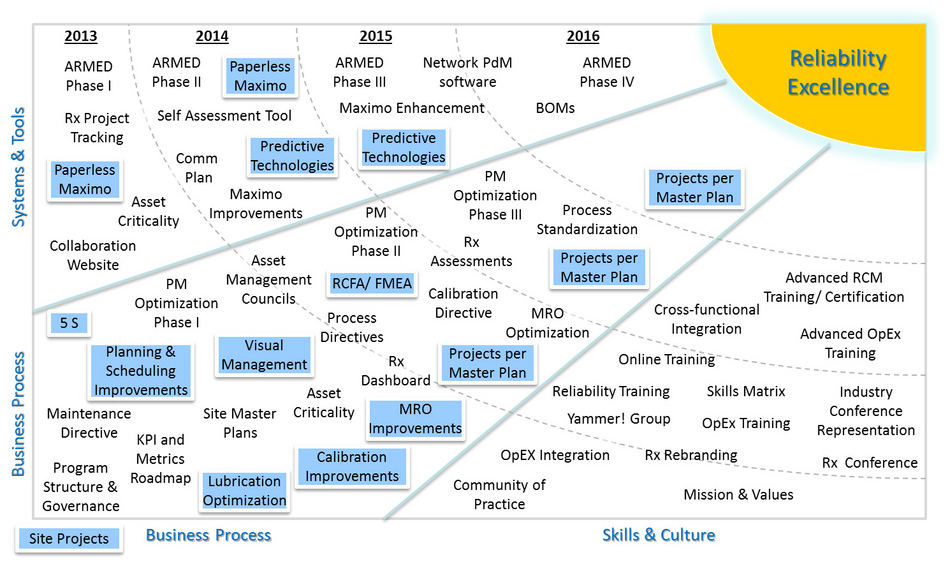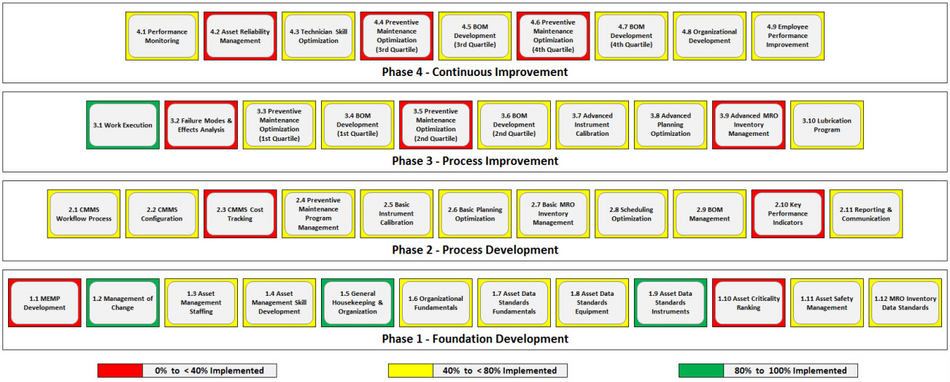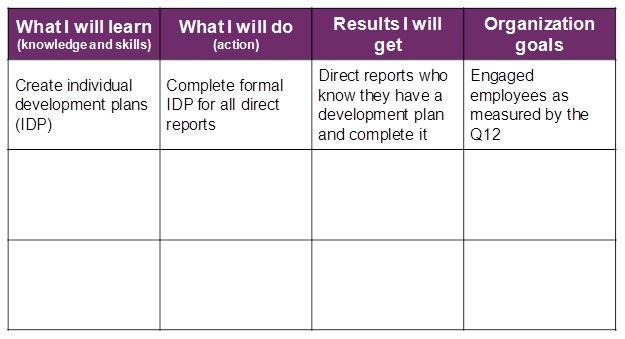Achieving Reliability Excellence through Customized Training: Bristol-Myers Squibb’s Journey
By George Williams, Associate Director, Global Asset Management, Bristol-Myers Squibb and Bill Wilder, Director, Life Cycle Institute
Bristol-Myers Squibb (B-MS) is on a four-year Reliability Excellence® journey that requires changes in business processes, systems, tools, skills, and culture. B-MS began by engaging leaders in supporting and promoting reliability best practices. They also sought to build competency in the application of standard processes and best practices in reliability. This was a multi-site initiative that required buy-in training for employees from site leaders to technicians across 12 plants located in the United States, Mexico, Puerto Rico, Italy and Ireland.

Figure 1: Bristol-Myers Squibb Reliability Excellence Journey
The success of a comprehensive performance improvement program like Reliability Excellence depends on stakeholders understanding the business case and supporting the changes. To achieve this B-MS defined the desired state and conducted assessments that identified improvement opportunities. The assessments served the additional purpose of creating awareness of the Reliability Excellence vision. Each site had 42 areas assessed across four phases.

Figure 2: Bristol-Myers Squibb Assessment Results Example
Armed with the opportunities determined through the assessment and the awareness created at each site, B-MS collaborated with the Life Cycle Institute at Life Cycle Engineering (LCE), to design, develop and deliver a communications program and competency-building learning process.
One of the gaps identified was an understanding of reliability and the benefits of a culture of reliability. To achieve this awareness the Reliability Excellence team delivered a Reliability Excellence Overview (RXO) for stakeholders at all levels. This ranged from site leadership to technicians.
The objectives of the two-hour RXO presentation were:
1. Create awareness of increased importance of reliability to B-MS
2. Provide an update on the Reliability Excellence program
3. Benefits of reliability
4. Review assessment performance
5. Define the role of leadership in driving a culture of reliability
B-MS site leadership, B-MS corporate and LCE delivered RXO. The site leadership team demonstrated commitment and active engagement in the initiative including the benefits for the site. Corporate reliability presented how Reliability Excellence contributed to corporate goals and objectives. They also shared the assessment data from all the sites. The LCE team shared reliability best practices and the roles of each player.
Ultimately, the RXO session was designed to establish these 12 attributes of sustained behavior change.
1. Provide clarity on sustainability goals, resources, plan and governance
2. Define, communicate and track success metrics
3. Define the role of change leads
4. Reinforce the messages – continued communication and engagement
5. Provide additional training where needed
6. Share and document the learnings and output
7. Determine actions that remediate gaps and cement change
8. Model changes by leaders
9. Ensure key stakeholders buy-in and accept ownership
- Stakeholders adopt and sustain the change
- Behavior change of the people involved in or impacted by the change
10. Recognize and celebrate those modeling the change
11. Anchor changes firmly in the corporate culture
12. Focus on continuous improvement
Following delivery of RXO, competency building programs were delivered at each site. These were selected based on the gaps identified in the assessment and the opportunities for improvement. The focus was on predicting failure, preventing failure and managing work. The topics covered were root cause failure analysis, failure mode and effects analysis, predictive maintenance technologies, and planning and scheduling.
LCE’s team of certified instructional designers (CPLP), change management professionals, certified maintenance and reliability professionals (CMRP), project managers (PMP) and facilitators worked with B-MS to create a customized tailored reliability excellence curriculum. Classes were designed to create pull for investing in best-practice processes, establish reliability competencies and create accountability.
This wasn’t just training. It was an exercise in changing behavior to achieve specific desired results. It was a learning process that acknowledges and leverages the fact that most people learn by doing. This process includes alignment on objectives and goals, assimilation of the knowledge and skills, and finally the application to achieve results. It is LCE’s proprietary 3A Learning Process® and it has been successfully deployed to create reliability cultures.

Figure 3: Life Cycle Engineering’s 3A Learning® Process
Phase 1 - Align
We began by working with the B-MS Reliability Excellence teams to create Learning Impact Maps for each course. This led to clear expectations for instructors (we call them facilitators), participants and leadership. This phase also includes the onsite Reliability Excellence awareness sessions for site leadership.
Before participating in a learning event participants should have a thorough understanding of what they are expected to learn, how their behavior is expected to change, the results they are expected to achieve, and how these results contribute to the overall goals of the organization. When this step is skipped, participants attend the learning event and are left entirely on their own to determine what they are supposed to do with what they learn. This often leads to a disconnect between participants and their leaders when they return to the workplace.
For example, when attending a Leading People class with a dozen learning objectives, a participant might discover some new tools for gaining group consensus and he knows these tools can be applied right away to make some decisions with his own team. Returning to work he excitedly shares these new ideas with his manager only to find that the manager really wanted him to learn how to facilitate the creation of a team vision. This was covered in class, but not knowing this was why he was selected to attend, he focused his attention on what he perceived to be an important skill.
Learning Objectives
Well-developed learning objectives are the foundation of a successful learning intervention. The learning objectives define the content, activities, and evaluation methods that are designed into the course. Effective learning objectives are active and measurable.
Active
The learning objective will define the action that the participant will be able to take. They are typically preceded by an action verb that is based on the level of cognitive learning desired. This is the single most important step in designing a course. Every minute of the course is designed to advance these objectives.
Measurable
Learning objectives should be measurable, meaning the training sponsor and the training provider will be able to gauge the effectiveness of the training in changing behavior to achieve results.
There are four levels of learning:
• Level 1: Reaction - Participant satisfaction. Did they like the class?
• Level 2: Learning - The extent to which participants change attitudes, improve knowledge and/or increase skill as a result of the training.
• Level 3: Behavior - The extent to which behavior changed as a result of the training. Are they applying what they learned?
• Level 4: Results - The final results that occurred because the participants attended the training.
What does it mean for the organization? Bloom's Taxonomy is a multi-tiered model of classifying learning according to six cognitive levels of complexity. Learning objectives should be developed to achieve a level of learning from Bloom’s Taxonomy. This insures that the appropriate number and level of activities are designed into the course and that the learning evaluation tool utilized accurately reflects results.
Learning Impact Maps
A Learning Impact Map accelerates alignment of learning investment with organizational goals. This alignment is the catalyst for behavior changes that produce the desired results. A Learning Impact Map will identify if the training can achieve the desired results in terms of broad business goals, prepare participants to learn and change their behavior based on the training and link the desired behavior with organizational performance and business goals.

Figure 4: Life Cycle Engineering’s Learning Impact Map
Phase 2 - Assimilate:
During this phase LCE ensured that each course delivered to the client was participant-centered, included adult learning principles, was led by effective facilitators, and incorporated a Learning Impact Map. The facilitators engaged the B-MS participants by playing on their prior knowledge and incorporating site-specific assessment data in class discussions.
During a learning event the focus is on assimilating the learning that resonates best with the participant. An effective learning event will engage the individual to apply what they already know in building relevant skills and knowledge that they can focus on and practice during the class. If these vital elements of an effective learning event are a part of the assimilation then the participant will return to work prepared to apply what they have learned. Otherwise, they may only have an awareness of and even a desire to apply these tools, but no practical experience on how to do it.
Participant-Centered Learning
Effective learning events should be designed to allow participants the opportunity to Hear, See, Question, Discuss, Do, and Teach. The objective is for the participant to be actively engaged in doing something as part of the learning and retention strategy. This includes group discussion, presentations, simulations, and case studies or something other than passively listening to a lecture. People learn best when training modules are kept to 90 minutes, the pace is changed every 20 minutes, and participants are involved every eight minutes. Participant-centered delivery increases retention and therefore potential for results.
Adult Learning
A successful learning event also recognizes that adults learn differently. Adults bring a wide range of knowledge, life experiences, interests and competencies to a learning experience and this diversity should be embraced in the development of education solutions. There are four principles of adult learning that should be incorporated into any active learning environment to help ensure knowledge transfer and retention.
1. Prior knowledge: Adults engage in learning with unique and often extensive prior knowledge that will aid or inhibit learning.
2. Relevance: Adults are ready to learn when they sense a need to cope with real-life situations.
3. Active: Adults who test and apply new knowledge and skills in the learning environment are more likely to change their behavior on the job.
4. Self-directed: Adults learn best when they take charge of their learning. Knowledge and skills are not the starting point! The average retention from a lecture is only 5%. Retention increases with various delivery methods with the highest from the hands-on application of knowledge and skills, i.e. teaching others.
Ultimately, it is the facilitator who makes the biggest impact. Whether assimilation happens effectively largely depends on who is leading your learning event. An instructor is a content resource, and usually shares knowledge through writing or lectures, appearing as a “sage on the stage”. A facilitator is a process manager first and a content resource second. Facilitators use their knowledge of how people learn to create an active environment that embraces participants’ prior knowledge and unique learning styles. When they facilitate, they appear as a “guide by the side,” with a passion for teaching that they have developed into a set of learning facilitation skills.
Skilled teachers do both: instruct and facilitate learning. The best facilitators should have completed a rigorous qualification process and are continuously engaged in activities that enhance their effectiveness at facilitating learning. This includes a rich repertoire of openers, closers, energizers, and interactive lecture techniques.
In addition to talented facilitators, the Institute assigned a project manager to lead the orchestration of logistical steps involved in the global training effort. The project manager, a certified PMP®, developed a process to document information unique to each site location and class delivery, and created and implemented a management of change process to track changes in scope, resources and schedule. The project team compiled data from facilitators and participants to provide feedback to the client using various communication methods, including regular status reports. This team was also instrumental in carrying out communication activities, ensuring accuracy in the production and delivery of course materials and scheduling resources.
Further, the project manager worked with the facilitators to complete a class report for each delivery which detailed what went well and opportunities for improvement and identified areas for additional support. A follow up plan and next steps were recommended which helped shape the final phase of the 3A Learning process – the Application Phase.
Phase 3 – Apply
Applying what one has learned is where 80% of learning takes place. It is using the skills and knowledge within the work environment that makes the learning stick, causing a behavior change that produces desired results. In this step it is important to experience early success. This early success depends on leadership support and coaching. If the training participant is left on his own, he is likely to discover unique factors in his work environment that make it difficult to apply what he has learned. The system, and often the people, resist change. Since learning is changing behavior, they will encounter resistance. They will need someone supporting them with encouragement, coaching, and running interference as they attempt to adapt their behavior.
LCE helped B-MS prepare for this phase by reviewing the facilitator reports and addressing action steps to be taken after the training. It is important to ensure that all participants have follow-up goals and that these goals are documented through a mentoring/coaching program.
Results
LCE implemented a fast-track or agile approach to accommodate B-MS’s time constraints. Five courses were developed in a one month period. Each site’s specific logistics and learning needs had to be addressed. Coordinating the deployment required frequent adjustments to the materials, locations and facilitator schedules.
Language was another challenge. LCE quickly engaged with proven, trusted partners to translate course material and deliver the customized courses in three different languages around the globe simultaneously. This included briefings on B-MS and LCE content.
The Life Cycle Institute delivered a total of 36 classes resulting in 509 training exposures. Four class offerings were customized to meet the client’s needs. Classes included a Reliability Overview class, Root Cause Failure Analysis/FMEA, Planning and Scheduling, and Predictive Maintenance.
Training was well received and course content across the 36 classes was rated at 4.4 on a scale of 1 to 5 with 5 being the highest rating. Class facilitators were recognized for being experienced authorities on their content and effective trainers with an average facilitator rating of 4.75. In fact, an average of 76% of participants rated their course facilitator with the highest rating possible of a 5.
“Overall, the class was very informative and will be extremely helpful getting us started with asset criticality, FMEA and root cause” stated an RCFA/FMEA class participant. A Planning and Scheduling participant affirmed, “Great job! Tools learned in class are very useful and are going to be an asset to improvement.”
As recognized by Bristol-Myers Squibb during their journey to Reliability Excellence, training delivers maximum results when a class inspires retention, management is involved, a Learning Impact Map is documented and a follow-through plan is in place. A learning process can help bring these elements together to create a reliability or asset management educational experience that changes behavior to achieve personal and organizational goals.
George Williams, CRL, CMRP, is the Associate Director, Global Asset Management, Bristol-Myers Squibb.
Bill Wilder, M.Ed., is the founder and director of Life Cycle Institute at Life Cycle Engineering. He has more than 20 years of experience helping organizations through change management and learning. You can reach Bill at bwilder@LCE.com.